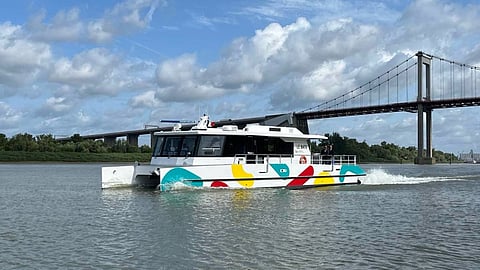VESSEL REVIEW | La Linotte – Hybrid waterbus to serve France's Bordeaux Metropole region
French shipbuilder OCEA recently handed over the first vessel in a new series of four catamaran waterbuses ordered by the Bordeaux Métropole region of southwestern France.
La Linotte will be operated as part of the region’s Le Bato shuttle boat network, which will transport passengers via the Garonne River.
The newbuild has an LOA of 21 metres (69 feet), a beam of 7.2 metres (24 feet), and a maximum draught of only one metre (3.3 feet). The air-conditioned main cabin has space for up to 70 passengers and 10 bicycles, whereas the three earlier waterbuses in the Le Bato fleet could each carry only 45 passengers and six bicycles.
Equipped for future installation of hydrogen propulsion
La Linotte and its sisters will increase the waterborne public transport network in the city of Bordeaux. It will also offer an extended network to diversify the public transport options available on the Garonne River.
The ferry's hull is made from recycled aluminium to help reduce environmental impact. The vessel also boasts a hybrid diesel-electric propulsion arrangement that includes rechargeable batteries, two generators, and waterjets. Long-term plans for the vessel include replacing the generator with lower-emission alternatives, such as hydrogen fuel cells.
"The boat will run primarily on batteries with the two diesel generators acting only as backup," Elvis Sahmanovic, Director of Maritime Transport and Mobility at OCEA, told Baird Maritime. "It can easily be refitted to run on hydrogen (H2) through the installation of a fuel cell and H2 cylindrical fuel tanks on the roof as soon as green H2 is available in Bordeaux.
"H2 pipe ducts are already integrated into the vessel, and the superstructure was designed from the outset to be able to accommodate the rooftop cylindrical tanks."
Sahmanovic added that the electric propulsion system is designed to meet stringent requirements such as having to serve a daily schedule and ensuring sufficient operating endurance (around 80 per cent of the time) with zero emissions. However, the generators can be used to further extend the endurance if needed.
Waterjets were selected since these are less susceptible to damage compared to propellers – an important consideration given the presence of vegetation and other debris floating on the Garonne especially at night.
“The owner required design, construction, and delivery to be completed within as short a timeframe as possible,” said Sahmanovic. “We delivered the first unit in July and the second in August. The final two units will be delivered early next year.”
The owner had decided against integrating charging stations at all stops on the vessel’s route, opting instead for charging at only one stop during nighttime. This then necessitated the incorporation of batteries with significantly higher capacity so that the vessel can operate for extended periods even with limited charging opportunities.
The propulsion system can be monitored remotely. This will help ensure a high degree of vessel availability in the event of a malfunction.
Designed for sustained operations
“The main challenges we encountered in designing the vessel were in ensuring the H2-ready propulsion system can be integrated into the limited space inside the twin catamaran hulls and that operating autonomy with zero emissions can be maintained even with the owner’s daily schedule,” said Sahmanovic.
“The boat needs to be able to operate 12 hours a day, seven days a week year-round, just like traditional buses on land, and so we selected onboard equipment that can withstand heavy daily use.”
Sahmanovic added the boat also needed to comply with European inland rules and regulations (ESTRIN), which were more restrictive than most other maritime rules that apply to vessel design.
“We learned that we can develop a new range of inland waterbuses with greater passenger and bicycle capacities even as regulations governing inland vessels are becoming more restrictive,” Sahmanovic told Baird Maritime.


